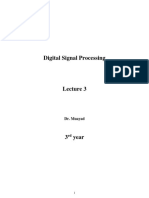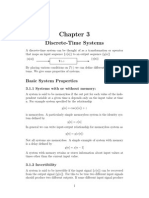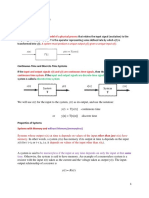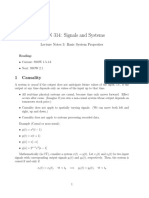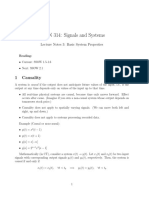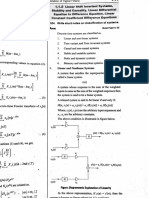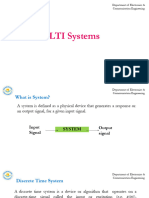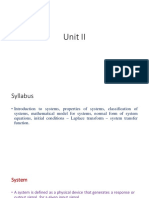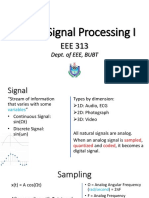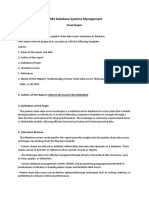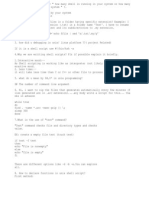Lecture 3:
Discrete Time Systems
Mathematically, a discrete time system is a transformation or mapping that maps an input
DT signal/sequence x[n] into an output sequence y[n]. This is represented by the following
equation
y[n] = T {x[n]} (1)
and is pictorially indicated in figure 1.
Figure. 1: Representation of a discrete-time system. Here T {} is the transformation that
maps an input sequence x[n] into a unique output sequence y[n].
Equation (1) is the rule that characterizes a system and is used to compute the output
sequences from the input sequence values. A continuous time (CT) system is mathematically
described by differential equation. For example, a mass-spring system with input force and
damping is represented by the following equation:
d2 x dx
m + γ + ω2x = F
dt2 dt
Where x is the displacement, m is the mass, γ is the damping factor, ω is the angular
frequency and F is the external force. Similarly, a DT system is described mathematically by
a difference equation. We’ll learn about difference equation and how to solve them in later
topics. An example of a difference equation is the following:
y[n] = x[n + 1] − 2x[n] + x[n − 1] (2)
For a given value of n if we know x[n], x[n-1] and x[n+1], we can compute y[n] from equation
(2). Classes of systems are defined according to the constraints on the properties of the
transformation T {.}. We’ll now discuss some classifications of discrete time systems.
1
�Linear and Non Linear System
The class of linear systems is defined by the principle of superposition. If y1 [n] and y2 [n] are
the responses of a system when x1 [n] and x2 [n] are the respective inputs, then the system is
linear if and only if
T {x1 [n] + x2 [n]} = T {x1 [n]} + T {x2 [n]} = y1 [n] + y2 [n] (3)
and
T {ax[n]} = aT {x[n]} = ay[n] (4)
where a is an arbitrary constant. Equation (3) is called the additive property and equation(4)
is the homogeneity or scaling property.
Additive property tells that for a linear system, the summation of inputs will produce an
output which is equal to the summation of the individual outputs. And homogeneity property
implies that if the input to a linear system is scaled by a factor of a, then the output will
also be scaled by the same factor. If any of these two properties is violated, the system is
not linear.These two properties can be combined into the principle of superposition. For
arbitrary a and b, ax1 [n] + bx2 [n] is called the superposition of x1 [n] and x2 [n]. There may
be more than two terms in a superposition. So for a linear system, if the superposition of
x1 [n] and x2 [n] are given as input, the corresponding output y[n] will be:
y[n] = T {ax1 [n] + bx2 [n]}
= T {ax1 [n]} + T {bx2 [n]}
(5)
= aT {x1 [n]} + bT {x2 [n]}
= ay1 [n] + by2 [n]
where the second line is due to additivity and third line is due to homogeneity property
of linear system. This equation can be generalized to the superposition of many inputs.
Specifically if X
x[n] = ak xk [n] (6)
k
then the output of a linear system will be
X
y[n] = ak yk [n] (7)
k
where yk [n] is the system response to the input xk [n]. This implies that if we know the
individual output of various inputs, we can compute the output of the superposition of those
input sequences. This is an important consequence of a linear system as we’ll see later.
Following points should be rememberred while deducing whether a system is linear or not.
1. System linearity is independent of any shifting, scaling or any polynomial terms in-
cluded in the time variable. For example, x[2n], x[n2 − 2n + 3]. Here 2n and n2 − 2n + 3
will not have any effect on system’s linearity.
2. System linearity is independent of coefficients used in system relationship.
2
� 3. If anything other than input/output is added or subtracted in the system’s difference
equation, the system will be non-linear.
4. Integrals and Differentials are linear operators.
5. Even and odd operators are linear operators.
6. Real, Imaginary and conjugate operators are non-linear operators.
7. Trigonometric, Polynomial, Inverse trigonometric, Exponential, Logarithmic, Rational
functions of inputs are nonlinear system. To sum up, if there is any non-linear function
of the inputs is in the difference equation, the system will be non-linear.
8. For a linear system, zero input will result in a zero output. But the inverse is not true.
Try Yourself
• Comment on the linearity and non-linearity of the following systems:
1. y[n] = y[n-1]+2x[n]+x[n-1]
2. y[n] = x2 [n] + x[n]
3. y[n] = x[n] + 10
4. y[n] = log10 (|x[n]|)
• Explain why the inverse of point 8 of the previous section is not true.
Time Invariant System
A time-invariant system (also referred to as shift invariant system) is a system for which the
output does not depend on when the input is given to it. In other words, if the input is
delayed or shifted by a certain amount, the output will also be shifted by the same amount.
Let us assume that a system transforms an input sequence x[n] into an output sequence y[n].
Then the system is said to be time-invariant if, for all n0 , the input sequence with values
x1 [n] = x[n − n0 ] produces the output sequence with values y1 [n] = y[n − n0 ].
Procedure for testing whether a system is time(shift) invariant (TIV) is summarized in the
following steps:
1. Let y1 [n] be the output sequence corresponding to x1 [n]
2. Consider x2 [n] which is the delayed/shifted version of x1 [n] by an amount k i.e.
x2 [n] = x1 [n − k]
Then find the output y2 [n, k] corresponding to x2 [n].
3. Now shift the output by the same amount k to produce y2 [n − k] = y1 [n − k].
3
� 4. If the system is time invariant, then y2 [n, k] = y2 [n − k] i.e. if the input is delayed by
k, the output will also be delayed by k.
Points to remember while determining if a system is TIV or not:
• Time scaling causes a system to be time variant.
• Time shifting by a constant term does not change time variance or invariance.
• Polynomial terms in the time index cause a system to be time variant.
• Coefficients should be constant. Any coefficient which is time dependent will make the
system TV.
Try Yourself
Determine if the following systems are TIV or TV:
1. y[n] = ∞
P
k=−∞ x[k]
2. y[n] = x[Mn] where M is a constant.
3. y[n] = x[-n]
1 Causal and Non Causal System
A system is causal if, for every choice of n0 , the output sequence value at the index n = n0
depends on the input sequence values for n ≤ n0 i.e. if the output depends on the past and
current values of input samples the system is called causal. For example, y[n] = x[n-1]+x[n].
For any value of n, the output will depend on the (n-1)th (past) and nth (current) values of the
input, so the system is causal. This implies that if x1 [n] = x2 [n] for n ≤ n0 , then y1 [n] = y2 [n]
for n ≤ n0 . For this reason, causal systems are nonanticipative. If a system is not causal, it
is called non-causal. For example, y[n] = x[n+1]+x[n-1].
Try Yourself
Determine if the system is causal or non-causal.
• y[n] = x[-n]+x[2n]
• y[n] = x[n2 − 2n + 3]+x[n-2]
4
�Stable and Unstable System
A system is stable in the bounded-input, bounded-output (BIBO) sense if and only if every
bounded input sequence produces a bounded output. Let us assume that the input x[n] is
bounded i.e. there exists a fixed positive finite value Bx such that
|x[n]| ≤ Bx < ∞ for all n (8)
For the system to be BIBO stable, for every bounded input, there exist a fixed positive finite
value By such that
|y[n]| ≤ By < ∞, for all n (9)
For example, consider a system y[n] = x2 [n]. If the input is bounded then there exists a
finite positive number Bx such that |x[n] ≤ Bx < ∞ for all n. Then y[n] = x2 [n] ≤ Bx2 < ∞.
Thus here By = Bx2 , so y[n] is bounded.
2 Try Yourself
Determine if the system is BIBO stable or not.
1. y[n] = log10 (|x[n]|)
1 + x[n]
2. y[n] =
2 − x[n]
3. y[n] = sin (x[n2 − 3n + 2)
References:
1. Continuous and Discrete Signals and Systems - Samir S. Soliman and Mandyam
D. Srinath.
2. Discrete-time Signal Processing, Alan V.Oppenheim, Ronald W.Schafer.
3. J.G Proakis and D.G Manolakis, Digital Signal Processing, Principles, Algo-
rithm, and Applications, 3rd ed., India: Prentice-Hall, 2000

